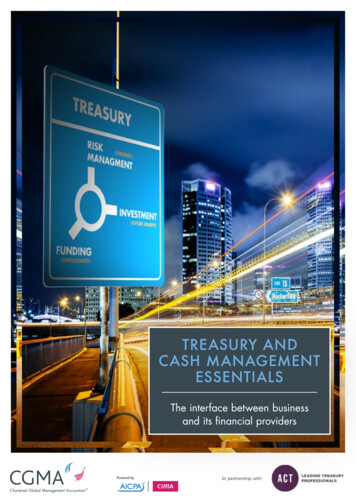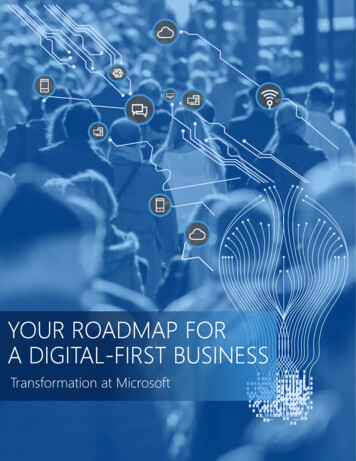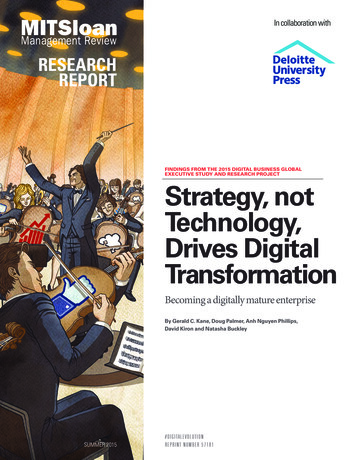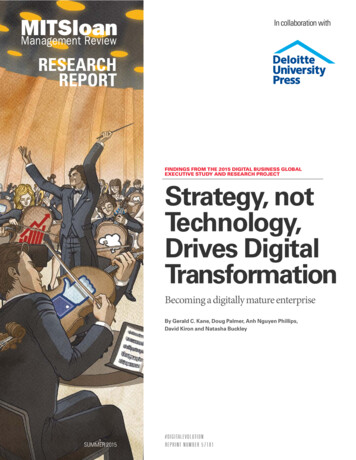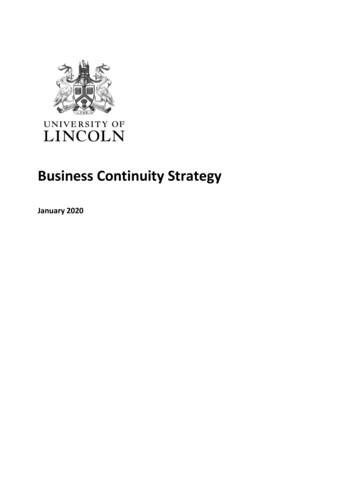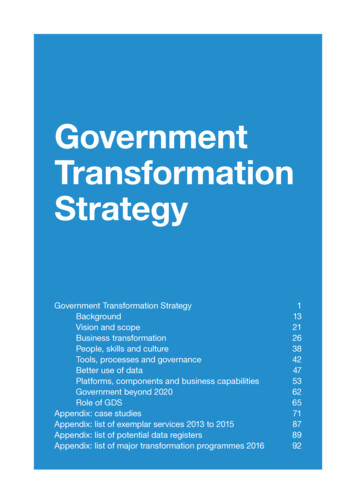
Transcription
GovernmentTransformationStrategyGovernment Transformation StrategyBackgroundVision and scopeBusiness transformationPeople, skills and cultureTools, processes and governanceBetter use of dataPlatforms, components and business capabilitiesGovernment beyond 2020Role of GDSAppendix: case studiesAppendix: list of exemplar services 2013 to 2015Appendix: list of potential data registersAppendix: list of major transformation programmes 2016113212638424753626571878992
NoteThis publication has three parts: the Government Transformation Strategy; additional detail covering background, scope, specific objectives,government beyond 2020 and the role of the Government Digital Service(GDS); and appendices, including case studies, services and data registers that havebeen and will be delivered.This document sets out the strategy in full. It explains what transformation ingovernment means in 2016 and beyond, and how this work will be done.Government Transformation Strategy: role of GDS2
Ministerial forewordTo govern is to serve. Our purpose is to maintain the security, safety andprosperity of the nation and to deliver what we have promised the people whoelect us.Yet it is too often the case that citizens feel that they live at the convenience ofthe state: that the government acts not as servant but as master. The result is aperception that the country works for the people who govern, not those whomthe government is tasked to serve. Whether it is a lack of belief in the capacity ofgovernment to deliver the pledges it makes at election time, or the frustrationsthrown in the way of people every day - from filling in a form to trying to talk tosomeone on the phone - government seems less and less capable of doing whatpeople want.The result of that disenchantment is plain to see. Here in the United Kingdomand elsewhere in the democratic world, people are expressing their wish for amore responsive state at the ballot box. It is a call that demands a reply; indeed,if we wish modern democracy to flourish, it is imperative we respond.This is no easy task. Government is more complex and wide-reaching thanever before. There is no company on earth - even the largest of multinationals which comes close to having to co-ordinate the array of essential services andfunctions for millions of people that a modern government provides. Equally ourduty is to serve everyone regardless of ability, age, gender, opinion or the placesin which they choose to live. For these reasons and because bureaucraciesare by their natures monopoly providers, government has been slow to use thetransformative potential of digital technology to change the way it does business.It is at a double disadvantage, therefore: big and slow. In a world where peoplerightly expect the government to deliver public services effectively and at speed,that makes the challenge more daunting still.The imperative is to change, therefore - and to do so at pace and at scale. Thisis the meaning of transformation. It is in essence a change of working, of cultureand of disposition - changes that are made possible by digital technology. Thattechnology is not change itself; it enables the change that is so transformative.How we can make that change happen is the subject of this strategy document.It describes the progress we have already made, from simplifying the smallestGovernment Transformation Strategy3
transactions between the citizen and the state to some of the largest reformprogrammes across the globe. This is only the beginning however: this strategycharts the direction of the total transformation of government - in how wework, how we organize ourselves and how we serve our citizens. It is the mostambitious programme of change of any government anywhere in the world, by agovernment that has already done more to transform itself than any other.I commend the brilliant, driven civil servants of this country and the wayin which they rise consistently to the challenge of delivering ever bettergovernment service. They prove every day that an inspiring, value-based publicservice ethos is alive and well in modern Britain. Yet achieving our ambitionsfor transformative public service will take a conscious and daily act of will onthe part of public servants in every part of this nation’s government. Unlikea business, we will not be forced to change by competition but must do soonly because it is the right thing to do. This is change purely in the interests ofpublic service; change that will make us fit servants of the people who ask usto govern. If we succeed, which we must, we will have done much to restoreour democracy to the position the people deserve.The Rt Hon Ben Gummer MPMinister for the Cabinet Office and Paymaster GeneralGovernment Transformation Strategy4
IntroductionBy harnessing digital to build and deliver services, the government can transformthe relationship between citizen and state. Much has been done since the 2012Government Digital Strategy, which demonstrated the potential of public servicetransformation by rebuilding some of the most high volume services to make them‘digital by default’. New digital professions are now established across the publicsector. Departments have become better at sharing platforms and components,code, patterns and best practice. This is a strong foundation upon which to build.The UK Government is one of the most digitally advanced in the world.We have come top of the 2016 United Nations E-Government andE-Participation surveys. We have developed the award-winning andinternationally renowned GOV.UK - and have opened its code which hasbeen reused by governments around the world. The Government DigitalService (GDS) has led the digital transformation of government and is amodel that is being copied internationally.Many departments have started to transform how they deliver services. This hasimproved citizens’ experience of a significant number of services, but in manycases it has not changed the way government organisations operate to deliverthem. It has meant that organisations without public-facing services have notbenefitted from the same degree of focus on digital transformation.The next stage of digitally-enabled transformation has three broad components,which together form the scope of this strategy: transforming whole citizen-facing services - to continue to improve theexperience for citizens, businesses and users within the public sector; full department transformation - affecting complete organisations to deliverpolicy objectives in a flexible way, improve citizen service across channelsand improve efficiency; and internal government transformation, which might not directly change policyoutcomes or citizen-facing services but which is vital if government is tocollaborate better and deliver digitally-enabled change more effectively.Increasingly, government departments will need to collaborate across traditionalorganisational boundaries. The vote to leave the European Union has heightenedthe need to be responsive and to be able to adapt to a changing environment.To build services that run seamlessly across government we must take the nextsteps in transformation. We will strengthen our digital capability. Where it meetsuser needs and satisfies the appropriate safeguards, we will make data easier toshare across government and ensure it is managed securely.Our commitment to digital transformation means that we must do this in away that takes into account the risks of the digital age. As the National CyberSecurity Strategy notes, cyber attacks are growing more frequent, sophisticatedand damaging when they succeed. We must therefore ensure that we moveforward in a way that is secure, deters criminal behaviour and which maintainsour commitment to individuals’ privacy.Government Transformation Strategy5
Read the background for a more in-depth review of government’s progress sincethe 2012 Government Digital Strategy.Vision and objectivesVisionWe will transform the relationship between citizens and the state - putting morepower in the hands of citizens and being more responsive to their needs.The tools, techniques, technology and approaches of the internet age give usgreater opportunities than ever before to help government: better understand what citizens need; assemble services more quickly and at lower cost; and continuously improve services based on data and evidence.We will transform government services and make government itself a digitalorganisation so that: citizens, businesses and other users have a better, more coherentexperience when interacting with government services - one that meets theraised expectations set by the many other (non-government) services andtools they use every day; elected governments can make a more immediate impact, delivering onpolicy goals by providing services and information more quickly, with theintended outcomes for their users - and the ability to change deliveryquickly if the policy changes; the cost and time to build, change and run government is reduced,saving public money and allowing government to respond faster to socioeconomic and political change; we improve trust between citizens and state, giving citizens confidence thattheir personal data is secure and being used in ways they expect, whilemaking government activity more transparent and making publicly-owned,non-personal data available for reuse where appropriate; and we build secure systems by default, ensuring that we create protectionagainst cyber crime through every stage of our digital transformation.ObjectivesIn order to transform the relationship between the citizen and the state, in theperiod to 2020 the government will: continue to deliver world-class digital services and transform the waygovernment operates, from front-end to back-office, in a modern andefficient way; develop the right skills and culture among our people and leaders, andbring together policy and delivery to enable services to be delivered in alearning and iterative environment, focused on outcomes for citizens; build better workplace tools and processes to make it easier for publicservants to work effectively, including sourcing, governance, workplaceGovernment Transformation Strategy6
IT, businesses cases, human resources processes, common technologyacross the public sector and better digital tools for civil servants; make better use of data - not just for transparency, but to enabletransformation across government and the private sector; and create, operate, iterate and embed good use of shared platforms andreusable business capabilities to speed up transformation - includingshared patterns, components and establishing open standards.This strategy is structured around these five objectives. For each objective, weset out what we will achieve by 2020.We will work on the basis that: following the Design Principles, the Digital Service Standard andTechnology Code of Practice, we will continue to start with user needs; users need a consistent experience of government services, unaffected bygovernment decisions to structure itself differently to deliver the prioritiesof the day; public servants, intermediaries and businesses are users too, and that tosucceed, we must understand their needs; everything will be designed and maintained with the right level of security in particular for sensitive or personal data; departments retain responsibility for risk around delivery regardless of thesourcing arrangements; and we design for security, building the appropriate cyber and privacysafeguards into our digital transformation.Read the vision and scope for more about the thinking behind these objectives.Business transformationWhile we have made huge progress in recent years, there are still many existingservices that need improving. We can still do far more to build ‘online services so goodpeople prefer to use them’ - the ambition of the 2012 Government Digital Strategy.Based on what we have learned, there’s a cross-government consensus on howthe scope of service transformation must expand. It must: bring policy development and service design closer together; cover the internal workings of departments as well as the services theyoffer to users; broaden the definition of users, for example to reflect that some users willinteract with government through third-party services that use governmentAPIs (application programming interfaces); recognise that government delivers services through a variety of channels(including online, telephone and face-to-face); cover departments that do not have many online services that citizensdirectly interact with; ensure government can provide content and services, and run projectsacross organisational boundaries; and be flexible in ways of working.Government Transformation Strategy7
What we will do by 2020The government has the following areas of priority for this Parliament: design and deliver joined-up, end-to-end services; deliver the major transformation programmes; and establish a whole-government approach to transformation, laying theground for broader transformation across the public sector.To do this: departments and agencies will keep working to improve the userexperience of government services radically by building digital servicesthat meet the Digital Service Standard; departments will complete their transformation programmes on theGovernment Major Projects Portfolio (GMPP) and others which werecommitted to in their 2015 Spending Review settlements, delivering multichannel services which are accessible to all; departments will find ways to experiment with transformation approachesand learn about what works and what does not; we will establish a cross-government mechanism to build a commonlanguage, tools and techniques, and share knowledge and experienceabout how to approach major transformations from across government,drawing on learning from the private sector; we will build a framework for the best way to deliver transformation acrossgovernment; and GDS will update the guidance supporting the Technology Code of Practiceand other applicable standards to support a strategic approach toreplacing old technology.Read more about our business transformation commitments, including a list ofimportant digital services that we will be monitoring specifically.Grow the right people, skills andcultureSince 2012, many more digital, data and technology specialists have beenrecruited across government, improving government’s technical capabilitysignificantly. The challenge now is to attract, recruit and retain specialists in avery competitive marketplace. In particular, we want to evolve our culture by: embedding digital skills throughout government;making sure digital experts understand government;making sure that civil servants of other professions understand digital;strengthening our leaders’ skills in agile project and programmemanagement; and establishing better ways to develop policy and deliver services in tandem using an agile approach to iterate rapidly.Government Transformation Strategy8
What we will do by 2020Our ambition is to have one of the most digitally skilled populations of civil servantsin the world, delivering the Civil Service vision to be ‘A Brilliant Civil Service’.We will do this by: establishing the principles around which we can best organise digital, dataand technology in departments; growing the digital, data and technology (DDaT) profession in government,including developing consistent career paths and reward structures; building the best possible learning and development opportunities forDDaT professionals through the Digital Academy; building government’s data science capability through the Data ScienceCampus and Data Science Accelerator training programme; making government a leader in attracting a diverse workforce for digital,data and technology roles; working with Civil Service HR and departments to make sure digital toolsand techniques are embedded in other professions; supporting non-digital specialists in understanding the potential of new ordifferent ways of working; working with Civil Service Learning to make sure that current and futureleaders have the right training and experience to manage digital projectseffectively, work in an agile way and manage digital-age organisations; and making policy based on user research, to enable iteration over time withincreased collaboration between the policy and service design communities.Read more about our people, skills and culture commitments.Build better tools, processes andgovernance for civil servantsA digital government does not just deliver excellent public services for its users.It creates the right environment for world-class public services by having theright digital tools, workplace technology, governance and processes. Today thereis wide diversity across government organisations in: the daily technology used by civil servants;how programmes of work are managed and governed;whether internal processes and controls support agile policy-making;sourcing (both commercial and procurement); andassurance (including quality control, service assurance and value for money).What we will do by 2020We will create empowering workplaces by: making sure government buildings have common, interoperable technologyand that the design and use of space helps to create a culture of open,digitally enabled policy-making and service delivery;Government Transformation Strategy9
giving public servants the right, location-independent tools to do theirjobs; and investigating the case for better digital services for civil servants byexploring opportunities across government for common digital tools forstandard government functionsWe will make sure all parts of government can govern, fund and effectivelyoperate agile services, including where services span departmental boundaries.Building on the Digital Marketplace’s approach, we will embed user-centred,design-led, data-driven and open approaches in procurement and contractingacross government by 2020.Read more about our tools, processes and governance commitments.Make better use of dataData is a critical resource for enabling more efficient, effective government andpublic services that respond to citizens’ needs. Data acts as the foundation uponwhich everything else rests.We must earn and retain the trust of citizens and provide reassurance thatpersonal and sensitive data is treated safely, securely and ethically withinappropriate governance frameworks.Government data is often held and used solely within the organisation thatcollected it and legacy systems make it hard to share information. There is toomuch duplication, overlap and contradiction in the datasets government holds.We need to get better at sharing data across organisational boundaries in waysthat citizens are comfortable with.What we will do by 2020In this parliament, we will focus on the following priorities: making better use of data as an enabler for public services, particularlywhere those services cross organisational boundaries; opening up government data where appropriate and continuing to open upgovernment services internally and externally through the use of APIs; removing barriers to effective data use in government by all parts ofgovernment through the data sharing provisions of the Digital EconomyBill, once it is passed by Parliament; appointing a new Chief Data Officer for government to lead on use of data; setting up a new Data Advisory Board to align efforts to make best useof data across government, which will oversee a number of examples ofbetter use of data and areas where we can build momentum; making better use of data to improve decision-making, by building andexpanding data science and analytical capability across government, foranalysts and non-analysts alike;Government Transformation Strategy10
managing and using data securely and appropriately, ensuring that publicsector workers understand the ethics of data sharing - including what isand is not permissible; building a national data infrastructure of registers (authoritative liststhat are held once across government) and ensuring they are securedappropriately; improving data discovery tools for users, both within and beyondgovernment; and transforming the way that government’s major repositories of data arestored and managed.Read more about our commitments for better use of data.Create shared platforms,components and reusablebusiness capabilitiesSince 2010 we have taken strong first steps in moving towards a morefundamentally digital government. We share code, patterns, platforms andcomponents. We share best practice for approaching technological and servicedesign problems that apply across government. Cross-government platformsand cross-government services are the future.We will build on the shared components and platforms to assemble businesscapabilities (the combination of the technology, processes and people requiredfor a business outcome).GOV.UK is the government’s single domain and the place where onlinetransactions start. We will establish how to make better use of GOV.UK forservices that span departmental boundaries (or which are provided by thirdparties, which could include local government or outsourced services).What we will do by 2020To make it quick, cheap and easy to assemble digital services and to providea consistent experience for users across all government services, we will buildmore reusable, shared components and platforms.Building on the work we have already done, our priorities for government upto 2020 are: exiting large, single supplier and multi-year IT contracts; building shared components and platforms, extending the use of the onesthat we have and onboarding more services; developing and publishing standards and implementation guidelines forcomponents, platforms and capabilities to make public sector reuse easier; removing barriers to component, platform and capability reuse, andexploring reuse beyond central government;Government Transformation Strategy11
operating the digital services and components GDS and departments havealready built on the GOV.UK single domain to a high standard of reliability,security and performance, and continuing to improve them to better meettheir users’ needs; making better use of GOV.UK Verify by working towards 25 million users by2020 and exploring options for delivery of identity services for businessesand intermediaries; ‘going wholesale’ by expanding the number of available and supportedAPIs, inside and outside of government, for example by allowingaccountants to submit tax returns automatically with the permission oftheir clients; sharing what we have built internationally and learning from best practice inother countries to continuously hone and improve our services; and overhauling government’s legacy content and outdated publishingpractices by 2020, so government services are clear, well maintained andeasier to find on GOV.UK.Read more about our commitments for platforms, components and businesscapabilities.The vision beyond 2020Most of our current major transformation projects are scheduled to be completeby 2021. However, transformation is a continuous process. While we deliverthese major programmes, we need to plan for post-2020. By ensuring weare adaptable and responsive to change, we will be able to keep pace withtechnology as it evolves. This will ensure that we can maintain our momentumto transformation government.To make government more flexible, we will make a clear plan for digitaltransformation beyond 2020. We will do the discovery and preparatory workneeded to understand what further changes government will need to make inorder to be fit for the digital age - changing how we change - including: how government structures may need to change in future; how policy is made, for example by creating early prototypes and iteratingquickly based on evidence and feedback; and any other changes that might be needed to enable our vision to bedelivered.Read more about our expectations for government beyond 2020.If we achieve these things, we will have reshaped government. We will be agovernment that puts the citizen first and meets their needs in a modern, efficientway: one that can adapt and change quickly to meet the needs of the country.Government Transformation Strategy12
BackgroundWhen we say transformation, we mean a significant step change in the way agovernment organisation delivers its services and in the way it operates. Anychange that government makes is driven by three considerations:1. Citizens: changing the way government interacts with citizens andbusinesses, whether online, at national borders, face-to-face, on the phoneor in an emergency.2. Policy: implementing the government’s policy agenda to make socialchange and change people’s lives.3. Efficiency: making government work in a more cost-effective way.One of the most powerful enablers of transformation in the early 21st century is toadopt the tools, techniques, technology and approaches of the internet age. Thisis what we define as ‘digital’. It is a cultural change as well as a technical one.Since 2010, the UK government has become one of the most digitally advancedin the world. The Government Digital Service (GDS) was created in 2011 as adigital centre of excellence for government. GOV.UK was launched in 2012. Bythe end of 2014 it had replaced the majority of department and agency websites.Departments created numerous digital services across government. GOV.UKVerify was developed as a way for users to prove their identity online securely.Two additional reusable components have been launched that make the jobof delivering services across government easier and the user experience moreconsistent: GOV.UK Pay and Notify.We have also invested heavily in skills and people, recruiting a large numberof digital specialists (most of whom work in departments) and improving thetraining available to public servants (through initiatives such as the Departmentfor Work and Pensions (DWP) Digital Academy which has trained almost 4,000staff since it was established in 2014).Departments have been transforming themselves to make the most of theopportunities created by digital technology, both to meet their users’ needs and tomodernise their internal operations. Millions of citizens now have the convenienceof doing business with government from their home or on the move at a time oftheir choosing - from April 2015 to March 2016 over 33 million people taxed theirvehicle online (and no longer need a paper record), 93% of vehicle tax and driverstransactions (about 200 million per year) were done online, over 4 million peopleapplied for a driving licence online and over 5.7 million people used the voterregistration digital service, with a peak of 469,000 applications in one day.Read the transformation case studies for more information about how: DWP is re-engineering the welfare system; HM Revenue and Customs (HMRC) is fundamentally rethinking tax in adigital age; HM Courts and Tribunals Service (HMCTS) is modernising the courts andtribunals system, enabled by digital services;Government Transformation Strategy: background13
HM Passport Office (HMPO) is moving to a modern, digital process where31% of customers already use either the online channel or the new onlinerenewal service, amounting to 2.2 million customers per year enjoying adigital experience; Office for National Statistics (ONS) is targeting 75% digital take-up in the2021 Census; Department for Education (DfE) is launching a digital apprenticeshipservice; and Department for Environment, Food and Rural Affairs (Defra) is transformingservices for its regulated customers.As a government, we are here to further the prosperity and security of the UK,to serve the citizen and to build on our position as a world-leading provider ofpublic services. The digital revolution kick-started by GDS in 2010 has seen usmake great strides. However, there is much more we still need to do. We mustreflect our increased experience and understanding. The government’s approachto digital must be comprehensive and we must expand our focus, underlined bythe creation of new senior roles with a wider government mandate.This strategy builds on those of previous governments and sets out what publicservants will do to continue to transform the public sector for the digital age. It isnot just about providing the digital services citizens rightly expect, but also aboutensuring that government continues to modernise itself on the inside. All of thismust be enabled by giving citizens confidence that the government will respecttheir personal data and identity. By doing so we can improve outcomes, delivera better service and improve the efficiency of our operations - transforming therelationship between citizen and state.Read more about GDS’s role in implementing this strategy.Digital contextWe all know the world is changing rapidly. The average British person nowspends around 1,500 online for goods each year, making us the most frequentonline shoppers in Europe. One of our major retailers made 4 in 10 sales onlinelast Christmas, with smartphones and tablets the fastest growing channel, up by31%. The UK digital economy is one of the most developed in the world, wortharound 145 billion a year.Globally, industries are being disrupted and transformed by software such asNetflix (entertainment) and Spotify (music), Uber (travel), Airbnb (accommodation)and Fitbit (health); retailers like Amazon are built around technology. There hasalso been a social media explosion: Facebook has nearly 1.8 billion active userseach month and has built a multi-billion dollar mobile advertising business fromscratch in the last few years.The accelerating pace of internet-enabled changeA set of common factors have come together to create a multiplier effect,enabling rapid
the Government Transformation Strategy; additional detail covering background, scope, specific objectives, government beyond 2020 and the role of the Government Digital Service (GDS); and appendices, including case studies, services and data registers that have been and will be delivered. This document sets out the strategy in full.

